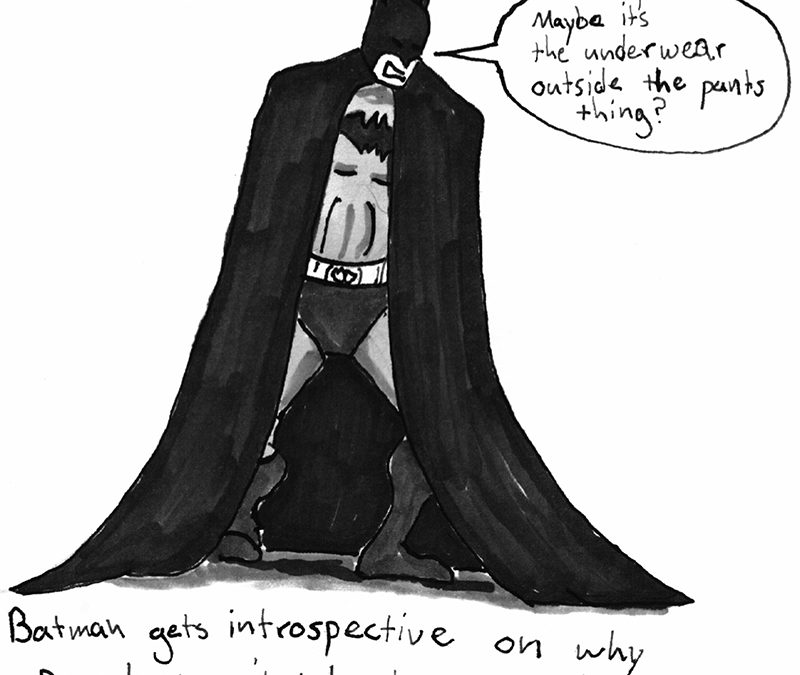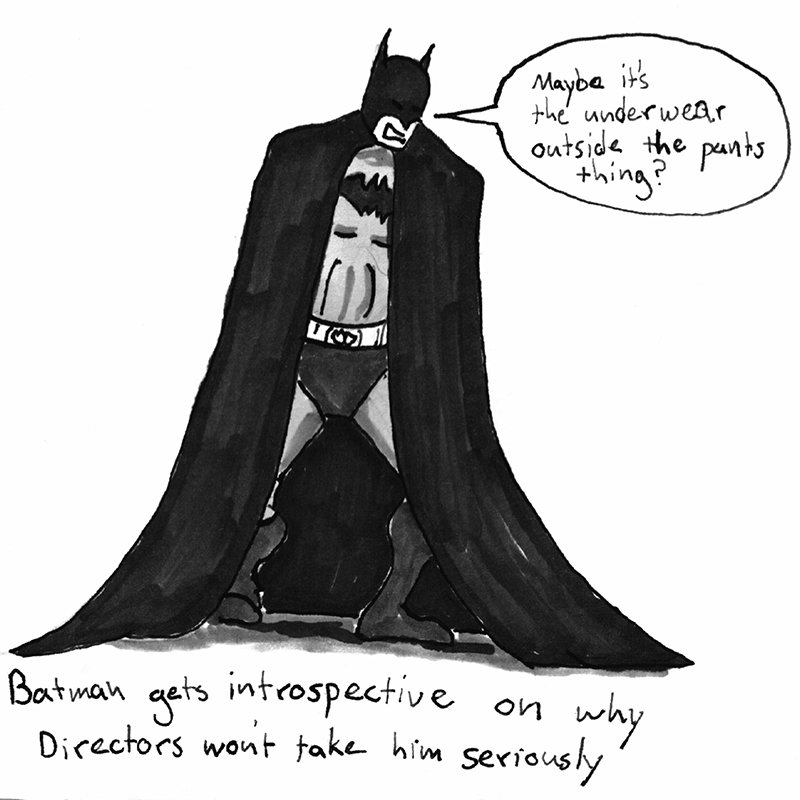Confession: I have very specific opinions about media depictions and reinterpretation of the character of Batman. I’ve been a Batman fan since I was barely old enough to walk.
I’ve discussed this elsewhere on more than one occasion (most recently here), but understand this: the ONLY reason a superhero or comics-based film, TV series, or other derivative media piece EVER really works is when the production company, writers, directors, and actors that work on that piece take the entire premise and inherent framework of that story ABSOLUTELY SERIOUSLY.
You can use humor or irony WITHIN the framework, and laugh WITHIN it. A good example of this is the first Donner Superman movie, which has comic elements, but which never for an instant betrayed the premise by laughing AT the premise (until Richard Lester took over as director and dragged that whole franchise into the camp comedy toilet).
Another pointed example of the difference can be found by comparing Shaun of the Dead with Zombieland. Shaun of the Dead is a riotously funny, loving tribute to the zombie film genre (notably George Romero’s seminal work). It was made by people who like zombie movies. It works brilliantly.
Zombieland was obviously made by people who think zombie movies are dumb. They spend half the movie explaining away or excusing things they think are stupid and trite about zombie movies. So the end result, while often funny, is funny because the makers are laughing AT the zombie movie genre, not taking it seriously in any way, shape or form.
The Batman serials of the 1940’s, the Superman TV show of the 1950’s, etc, were just not taken seriously by the industry. They were treated as fluff, stupid junk “for kids.” They didn’t make much sense because nobody cared whether or not they did. The writers and producers treated the original source material with contempt to crank out material that simply couldn’t be taken seriously. Nor did they mean it to be.
The Batman TV show of the 1960’s was an ironic (or “campy”) stab at the comics industry and the ridiculous, outrageous goofiness of the comics medium (ironic indeed, since that hack Fredric Wertham’s bogus research and the 1954 Comics Code it inspired had gone a long way toward turning comics into insipid pablum— mental baby food). It was intended to be a big silly joke making fun of Batman in particular and comics in general. It stabbed everything serious about comic books as a medium directly in the heart. It was fun, and funny— but it cannibalized itself, using the public regard for its source material as fuel so it could burn itself in effigy. Fortunately Marvel comics was on the rise, making inroads into comic story art as a serious medium for real storytelling. But comics had lost a lot of ground in other media. The cheaply-made Marvel comic cartoon series of the late 1960’s is evidence of it.
Batman was reinvented in the late 1960’s as a serious bad ass in comics (“The New Look”), but few apart from serious comics fans noticed because they were still humming the TV Batman theme song. The 1970’s had a few notable attempts to do serious (or semi-serious) superheroes on television, plus Richard Donner’s first Superman film which was 98% excellent (and 2% atrocious)… but never Batman. He had been publicly burned and lambasted as forever ridiculous.
Frank Miller’s The Dark Knight Returns almost singlehandedly brought the character back into vogue as a serious protagonist in 1985. Taking a cue from Marvel’s Wolverine (who was at that time a major fanboy favorite) and furthering the work of Neal Adams and Denny O’Neil, Miller reexamined Batman from the point of view of his odd psychological profile and ran with it, dragging him into a dystopian future Gotham landscape reflective of 1980’s conservative angst. It worked. Batman was back, dead serious, and newly relevant.
Which brings us to Batman at the movies, and the fact that EVERY LIVE ACTION FILM VERSION OF BATMAN THAT HAS EVER REALLY WORKED was based directly on Miller’s Batman: The Dark Knight Returns.
When Tim Burton did Batman in 1989, he LITERALLY carried a copy of The Dark Knight Returns rolled up in his back pocket and constantly whipped it out in front of his production designers, saying “I want this.” Not a Batman fan— but he took it SERIOUSLY. Dark, gothic, grotesque, brooding, and weird are Burton’s “thing.” He made Batman a lonely tormented PTSD victim and depicted Joker as a legitimate psychopath. He couldn’t resist tweaking it into the ghoulishly silly and making dumb character jokes— Burton always does that. But he took it SERIOUSLY.
There was a massive outcry when Michael Keaton was cast, just like the current internet whinge-a-thon over Ben Affleck. “Screw you, Mister Mom!” said everybody. But when the movie came out, people were pleasantly surprised. NOT because Keaton was the perfect Batman— far from it. He was miscast. BUT!
He took it seriously. He played it real. So… it worked, after a fashion.
The second movie, with its mutant carnies and rocket-firing penguins, was too weird even for hardcore Batman fans and lost a lot of ground. The third and forth ones were ruined by Joel Schumacher, who just couldn’t bring himself to play it seriously, and instead turned it increasingly more campy and silly. Kilmer was okay (if a bit too Hollywood) in the role, and Clooney MIGHT have been good— he was the right type— had he not been torpedoed by a horrible script and the idiotic-everything-else.
NOTE: It doesn’t matter if the actors all try to play it seriously, if the director is telling them to ham it up and play it over the top, while using his art department to make the cinematic equivalent of bunny ears behind their heads in every scene. Shame on you, Joel Schumacher. Your unprofessional refusal to support your material and your obvious disdain for its core concept buried a billion dollar franchise for ten years. Go make musicals.
The latest Batman trilogy— inspired, again, by Miller’s Dark Knight combined with Miller’s Batman Year One— initially blew everyone away because the director FINALLY got on board and played it straight without a bunch of kooky gargoyles or giant chrome statues and shit. Christian Bale was okay, but he got screwed when they wrote the character to be much dumber and more hamfisted than the comics version. Bale’s Batman wasn’t the world’s greatest detective, finely self-trained and well equipped with an arsenal of techniques to wage a one-man battle on crime— he was a James Bond-ish ninja who was trained by foreign terrorists and equipped by his convenient super-corporation with a bunch of cool shit they had lying around— who then immediately started defending Gotham from murderers by murdering the living shit out of mafia thugs.
Still, Christopher Nolan took it seriously. At least at first. Until the third film, when he seemed to say “ya know, fuck it, I’m just gonna film a lot of cool action shit that makes no sense and top it off with your standard messianic die-for-Gotham’s-sins metaphor. And a non-ending ending.”
Nolan bent his Batman’s reality far enough for him to stay serious, for awhile, but in the end he resorted to seriously altering the character and his world in order to sustain his dwindling faith in the character’s believability. It became “Nolan’s Batman,” not THE Batman.
Now we have Affleck, and everyone is going “Screw you, Gigli-Guy!” Same thing they did with Keaton.
We’ll see. But EVERYTHING DEPENDS ON IF THEY TAKE THE SUBJECT MATTER SERIOUSLY.
And if they screw it up again, by trying to cram too many famous comic book story lines and characters into one “Greatest Hits of Every DC Comic Book Franchise” JLA knock off?
I’m not all that worried. Because if they screw it all up again, they’ll keep trying. As long as Batman remains one of the most popular characters in the history of popular fiction, there will always be someone willing to step up and attempt to finally realize the character properly in a live-action venue.
Meanwhile, 100 million Batman fans can’t be wrong. Writers, directors, producers, and production teams need to stop changing things to put their personal “spin” on the character and simply tell the tale as envisioned by Bill Finger and Bob Kane, updated by Adams, O’Neil, Infantino, Fox, Miller, Moore, Moench, Loeb, and the rest of the cutting edge contributors that have kept the character fresh and relevant for 73 years.


